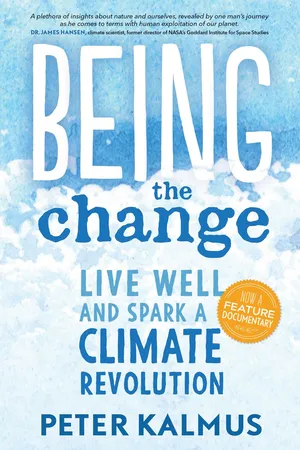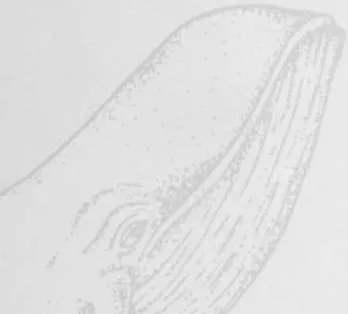![]()
PART I
PREDICAMENT
Full fathom five thy father lies;
Of his bones are coral made;
Those are pearls that were his eyes:
Nothing of him that doth fade
But doth suffer a sea-change
Into something rich and strange.
— WILLIAM SHAKESPEARE, The Tempest
![]()
CHAPTER 1
Waking Up
Trees and people used to be the best of friends.
I saw that tree and decided to buy the house.
— HAYAO MIYAZAKI, My Neighbor Totoro
I knew that burning fossil fuels was causing irreversible harm to our planet’s life-support systems. And yet I continued to burn.
When I first heard of global warming1 in sixth grade—the only time it was mentioned during my school years—it seemed like science fiction, not something that would ever concern me. I didn’t think about it again for nearly two decades.
I began learning the basic science of global warming in 2006 when my first son, Braird, was born. Fatherhood jolted me out of a selfish careerism. Suddenly my life wasn’t just about me, and my perspective shifted to a longer time scale. At the time, I was working on my PhD in physics at Columbia University in New York City. As my eyes were opened, I had a strong emotional response: how could we continue burning fossil fuels at an accelerating pace when this severely damages the biosphere for future generations? It seemed insane. At the same time, I was immersed in our industrial civilization, which dictates that burning fossil fuels is the only sane thing to do—that someone who refuses to burn fossil fuels is ludicrous, a Luddite.
I became obsessed with finding some way to rectify this deep inconsistency. I longed to know how all of the people around me—family members, colleagues, strangers on the street—were dealing with this glaring disconnect without any apparent difficulty. Did they know about global warming? Had they made peace with it somehow, or did they simply not think about it? I felt afraid of the future, lost. I had so much emotional static that I struggled to connect with people.
Like a splinter in my psyche, this disconnect required me to do something. But what?
I first tried converting people with facts. The people around me were acting as though there wasn’t a problem: perhaps they simply didn’t know. If I could only communicate with greater clarity, people would “get it.” I felt like I had the truth, that my job was to wake everyone up.
Like most attempts to convert, though, mine were sanctimonious and alienating. It was impossible for anyone to listen to me, or for me to listen to anyone else. (My wife, Sharon, had to put up with a lot; it’s not easy being married to someone who wants to convert you.) This led to even more disconnection. Alone with my angst, at a loss for what to do, I was panicking.
I now realize that few people respond to facts. I also realize that I can’t respond meaningfully to our predicament with my intellect alone. I also doubt that even our society’s collective intellect, our best scientists and brightest policymakers working within their delineated roles, will be enough. While intellect certainly plays a role, it’s a rather small one. Our dire ecological crisis calls us to go deeper.
Going deeper
A few years passed before I began to develop a more coherent response. In 2008, our second child, Zane, was born, and we left New York so I could take an astrophysics job at the California Institute of Technology. But before leaving New York, I was offered a job in atmospheric science at NASA’s Goddard Institute for Space Studies (GISS), which at the time was led by James Hansen. Had I accepted it, I’d have worked to improve the representation of clouds in the GISS global climate model. But I didn’t feel ready for such a big career change, and my ongoing work of searching for gravitational waves—ripples in the fabric of spacetime—was incredibly exciting. So, after much soul searching, I accepted the Caltech job and continued my work of sifting through LIGO data for scientific gold. Sharon and I moved to Altadena, a suburb northeast of Los Angeles in the foothills of the San Gabriel Mountains where parrots roam the skies and orange trees abound. I felt like I’d landed in paradise.
We chose a house because of the magnificent avocado tree in the backyard. I bonded with this tree. I began to think of it as a friend, and I still do. This relationship with a tree began to change me: I began to understand plants as beings.2
After a year of renting, we bought the house. For the first time in my life, I owned a tiny patch of land. I decided to cancel the mow-and-blow landscaping service and tend my own yard. The land seemed alien; I didn’t know what any of the plants were called or how to take care of them. But I did know that I love to eat tomatoes, so I planted some tomato plants. I enjoyed their company so much—their smell and their just-perceptible daily growth, their being-ness—that I felt called to plant other little beings. I dismantled a small deck by my back fence that we never used, took a sledgehammer to the underlying concrete (quite a joyous task, it turned out), and turned the scrap lumber into six raised beds. I’d caught the gardening bug. Before long I ripped out the grass of my front lawn to make space for other, more interesting and useful plants.
This, then, is how I started to use my hands: the land drew me in. The land was like a painter’s canvas, full of possibility and potential. I could plant things on it. Choosing what to grow, and how, required a new kind of wisdom from me, something essentially human. It asked for more than intellect. It asked for connection and for humility, and it offered simple gifts. I fell in love with the land.
I could see a path stretching far into the distance, and I’ve come to understand that learning how to tend the land takes a lifetime.
Around this time, in 2010, I began to meditate seriously. Sharon and I had started meditating back in New York, but we simply weren’t able to maintain our practice while caring for babies. But one morning, after four years of diapers and inadequate sleep, I remembered how important meditation had been. So I went to a ten-day meditation retreat and started practicing again. This is how I started to know myself more deeply. My eyes opened to what was right in front of them. A few months later, Sharon went on her own retreat, and we began sitting together daily.
I began observing my daily life and changing it to be more aligned with what I knew. When faced with some daily task—commuting to work, planning a trip, eating, showering, whatever—I began perceiving how it connects to our industrial system’s preferred way of doing things, how it affects other beings and too often harms them. I began searching for alternative ways of doing things. This exploration often blossomed into adventure: unpredictable, fun, and satisfying.
As my scientific interest in global warming increased, it eventually occurred to me that I’d be happier studying it full-time. So I finally left the beautiful, giddy world of astrophysics. This was a sacrifice, and it meant sitting on the sidelines during humanity’s first detection of gravitational waves—an endeavor to which I’ve given nearly a decade of my life. But I simply could no longer concentrate on astrophysics; it felt like fiddling while Rome burned. I’m now an Earth scientist studying the role of clouds in a warming world. I’ve also reduced my personal CO2 emissions from about twenty tonnes per year (near the US average) to under two tonnes per year. Overall, this hasn’t been a sacrifice. It has made me happier.
Head, hands, and heart
The path I’m on has three parts. One is intellectual understanding: the head. The head allows me to prioritize. It helps me navigate to my goals, although I find it’s not always good at choosing those goals. One of the lessons I’ve learned is that I’m limited, in time, energy, and ability; if I’m to make any progress, I need to choose my path wisely. This means asking the right questions, gathering information about reality as it is (which is often different than how it appears to be, or how I want it to be), and drawing conclusions objectively. The head is a scientist.
Another part of my path is practical action: the hands. As we’ll see, society’s business-as-usual trajectory is carrying us toward disaster. If we wish to avoid disaster, we must take action. Since I can’t change the entire global trajectory single-handedly, I perform practical and lo...

